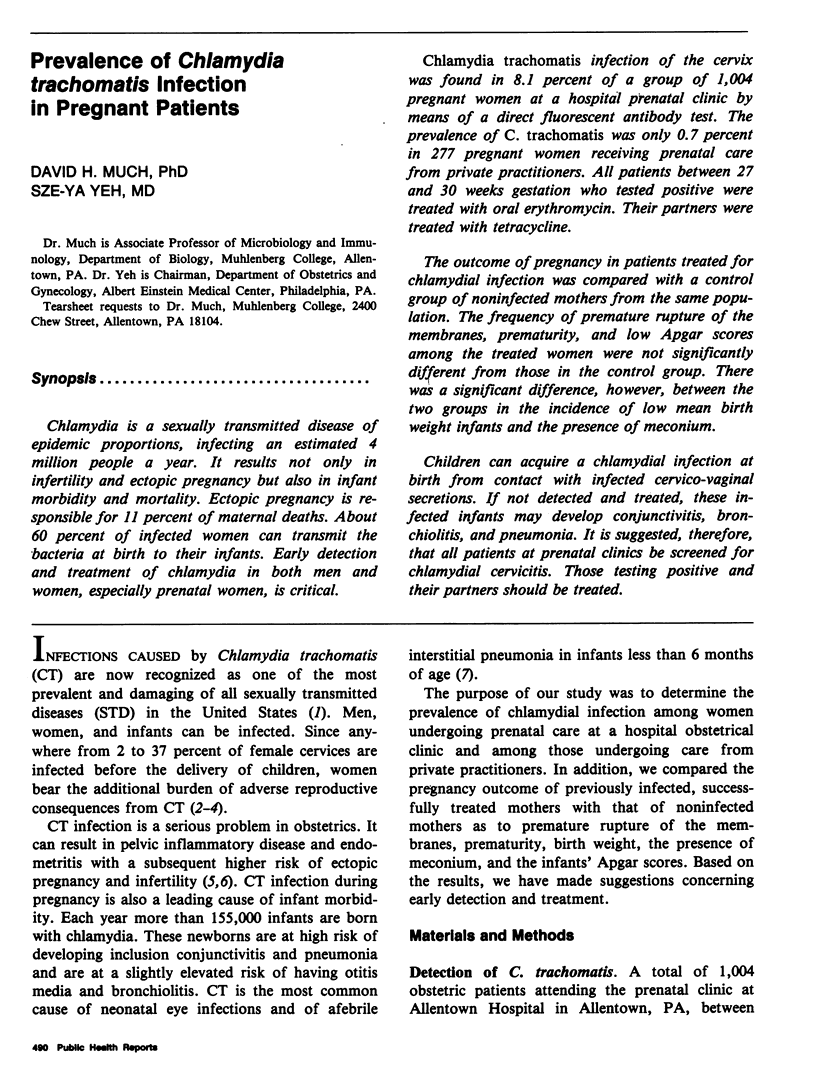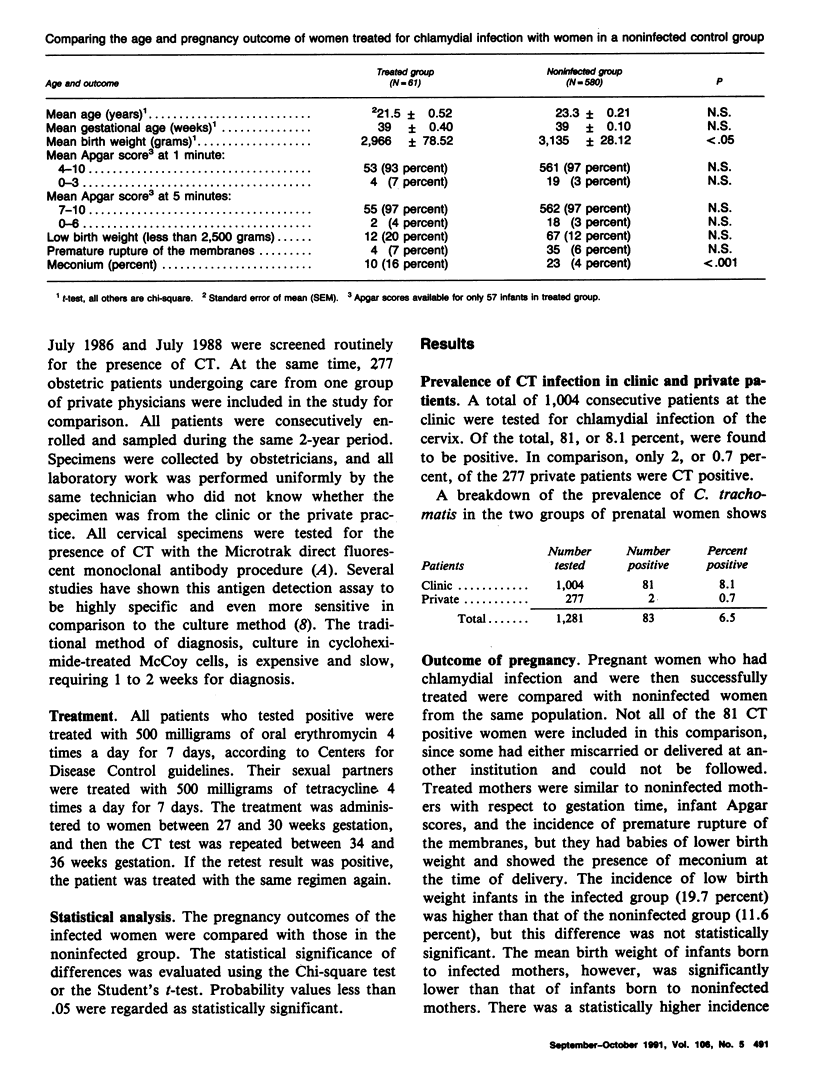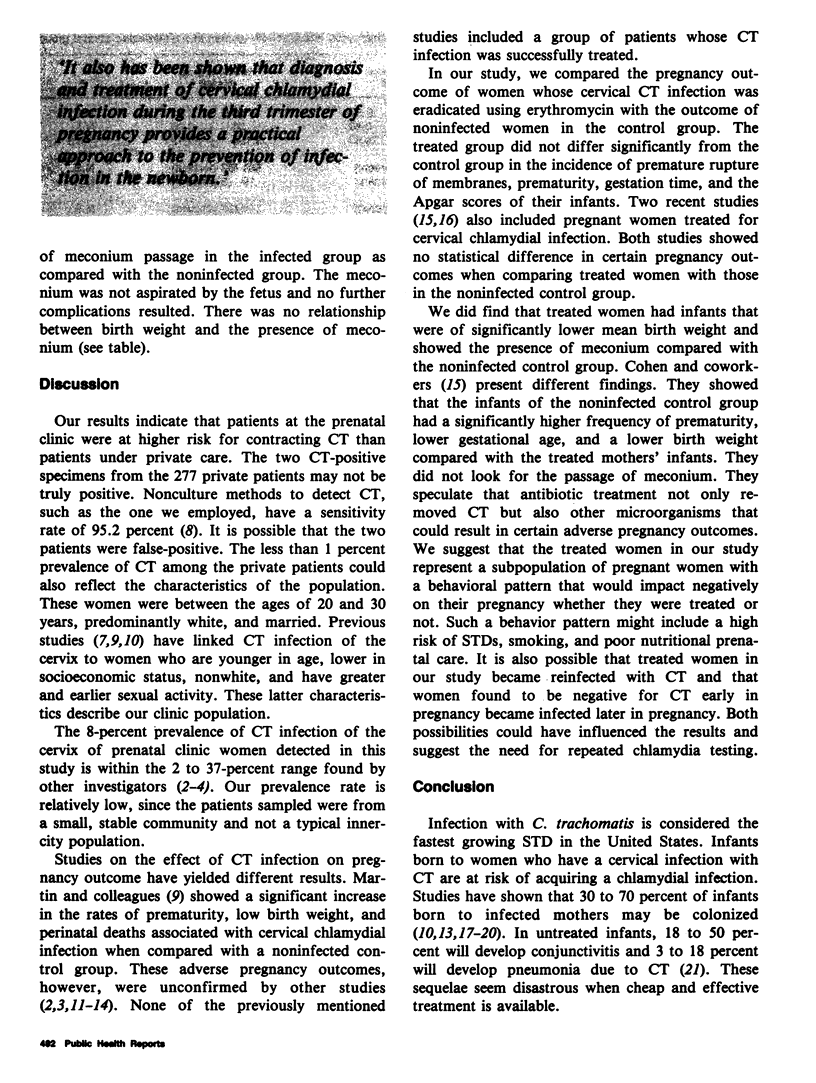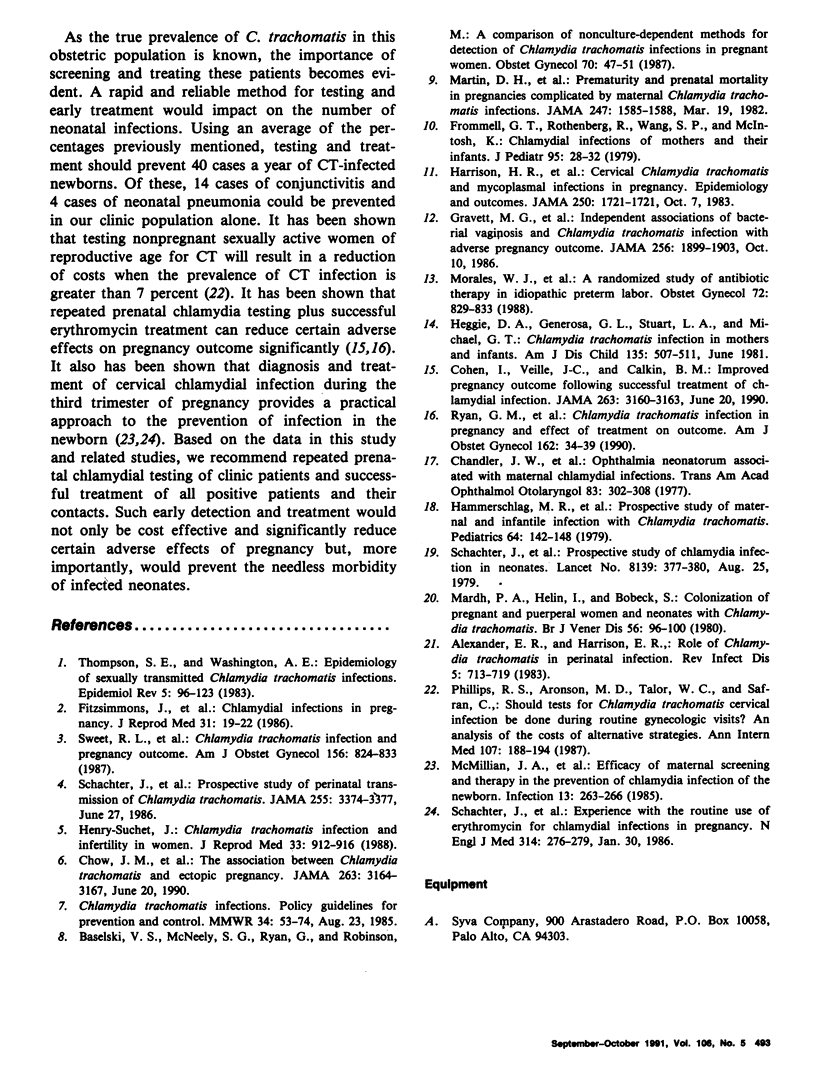Abstract
Chlamydia is a sexually transmitted disease of epidemic proportions, infecting an estimated 4 million people a year. It results not only in infertility and ectopic pregnancy but also in infant morbidity and mortality. Ectopic pregnancy is responsible for 11 percent of maternal deaths. About 60 percent of infected women can transmit the bacteria at birth to their infants. Early detection and treatment of chlamydia in both men and women, especially prenatal women, is critical. Chlamydia trachomatis infection of the cervix was found in 8.1 percent of a group of 1,004 pregnant women at a hospital prenatal clinic by means of a direct fluorescent antibody test. The prevalence of C. trachomatis was only 0.7 percent in 277 pregnant women receiving prenatal care from private practitioners. All patients between 27 and 30 weeks gestation who tested positive were treated with oral erythromycin. Their partners were treated with tetracycline. The outcome of pregnancy in patients treated for chlamydial infection was compared with a control group of noninfected mothers from the same population. The frequency of premature rupture of the membranes, prematurity, and low Apgar scores among the treated women were not significantly different from those in the control group. There was a significant difference, however, between the two groups in the incidence of low mean birth weight infants and the presence of meconium. Children can acquire a chlamydial infection at birth from contact with infected cervico-vaginal secretions. If not detected and treated, these infected infants may develop conjunctivitis, bronchiolitis, and pneumonia. It is suggested, therefore, that all patients at prenatal clinics be screened for chlamydial cervicitis.(ABSTRACT TRUNCATED AT 250 WORDS)
Full text
PDF



Selected References
These references are in PubMed. This may not be the complete list of references from this article.
- Alexander E. R., Harrison H. R. Role of Chlamydia trachomatis in perinatal infection. Rev Infect Dis. 1983 Jul-Aug;5(4):713–719. doi: 10.1093/clinids/5.4.713. [DOI] [PubMed] [Google Scholar]
- Baselski V. S., McNeeley S. G., Ryan G., Robison M. A comparison of nonculture-dependent methods for detection of Chlamydia trachomatis infections in pregnant women. Obstet Gynecol. 1987 Jul;70(1):47–52. [PubMed] [Google Scholar]
- Chandler J. W., Alexander E. R., Pheiffer T. A., Wang S. P., Holmes K. K., English M. Ophthalmia neonatorum associated with maternal chlamydial infections. Trans Sect Ophthalmol Am Acad Ophthalmol Otolaryngol. 1977 Mar-Apr;83(2):302–308. [PubMed] [Google Scholar]
- Chow J. M., Yonekura M. L., Richwald G. A., Greenland S., Sweet R. L., Schachter J. The association between Chlamydia trachomatis and ectopic pregnancy. A matched-pair, case-control study. JAMA. 1990 Jun 20;263(23):3164–3167. [PubMed] [Google Scholar]
- Cohen I., Veille J. C., Calkins B. M. Improved pregnancy outcome following successful treatment of chlamydial infection. JAMA. 1990 Jun 20;263(23):3160–3163. [PubMed] [Google Scholar]
- FitzSimmons J., Callahan C., Shanahan B., Jungkind D. Chlamydial infections in pregnancy. J Reprod Med. 1986 Jan;31(1):19–22. [PubMed] [Google Scholar]
- Frommell G. T., Rothenberg R., Wang S., McIntosh K. Chlamydial infection of mothers and their infants. J Pediatr. 1979 Jul;95(1):28–32. doi: 10.1016/s0022-3476(79)80077-3. [DOI] [PubMed] [Google Scholar]
- Gravett M. G., Nelson H. P., DeRouen T., Critchlow C., Eschenbach D. A., Holmes K. K. Independent associations of bacterial vaginosis and Chlamydia trachomatis infection with adverse pregnancy outcome. JAMA. 1986 Oct 10;256(14):1899–1903. [PubMed] [Google Scholar]
- Hammerschlag M. R., Anderka M., Semine D. Z., McComb D., McCormack W. M. Prospective study of maternal and infantile infection with Chlamydia trachomatis. Pediatrics. 1979 Aug;64(2):142–148. [PubMed] [Google Scholar]
- Harrison H. R., Alexander E. R., Weinstein L., Lewis M., Nash M., Sim D. A. Cervical Chlamydia trachomatis and mycoplasmal infections in pregnancy. Epidemiology and outcomes. JAMA. 1983 Oct 7;250(13):1721–1727. [PubMed] [Google Scholar]
- Heggie A. D., Lumicao G. G., Stuart L. A., Gyves M. T. Chlamydia trachomatis infection in mothers and infants. A prospective study. Am J Dis Child. 1981 Jun;135(6):507–511. doi: 10.1001/archpedi.1981.02130300007005. [DOI] [PubMed] [Google Scholar]
- Martin D. H., Koutsky L., Eschenbach D. A., Daling J. R., Alexander E. R., Benedetti J. K., Holmes K. K. Prematurity and perinatal mortality in pregnancies complicated by maternal Chlamydia trachomatis infections. JAMA. 1982 Mar 19;247(11):1585–1588. [PubMed] [Google Scholar]
- McMillan J. A., Weiner L. B., Lamberson H. V., Hagen J. H., Aubry R. H., Abdul-Karim R. W., Sunderji S. G., Higgins A. P. Efficacy of maternal screening and therapy in the prevention of chlamydia infection of the newborn. Infection. 1985 Nov-Dec;13(6):263–266. doi: 10.1007/BF01645435. [DOI] [PubMed] [Google Scholar]
- Morales W. J., Angel J. L., O'Brien W. F., Knuppel R. A., Finazzo M. A randomized study of antibiotic therapy in idiopathic preterm labor. Obstet Gynecol. 1988 Dec;72(6):829–833. doi: 10.1097/00006250-198812000-00002. [DOI] [PubMed] [Google Scholar]
- Mårdh P. A., Helin I., Bobeck S., Laurin J., Nilsson T. Colonisation of pregnant and puerperal women and neonates with Chlamydia trachomatis. Br J Vener Dis. 1980 Apr;56(2):96–100. doi: 10.1136/sti.56.2.96. [DOI] [PMC free article] [PubMed] [Google Scholar]
- Phillips R. S., Aronson M. D., Taylor W. C., Safran C. Should tests for Chlamydia trachomatis cervical infection be done during routine gynecologic visits? An analysis of the costs of alternative strategies. Ann Intern Med. 1987 Aug;107(2):188–194. doi: 10.7326/0003-4819-107-2-188. [DOI] [PubMed] [Google Scholar]
- Ryan G. M., Jr, Abdella T. N., McNeeley S. G., Baselski V. S., Drummond D. E. Chlamydia trachomatis infection in pregnancy and effect of treatment on outcome. Am J Obstet Gynecol. 1990 Jan;162(1):34–39. doi: 10.1016/0002-9378(90)90815-o. [DOI] [PubMed] [Google Scholar]
- Schachter J., Grossman M., Sweet R. L., Holt J., Jordan C., Bishop E. Prospective study of perinatal transmission of Chlamydia trachomatis. JAMA. 1986 Jun 27;255(24):3374–3377. [PubMed] [Google Scholar]
- Schachter J., Sweet R. L., Grossman M., Landers D., Robbie M., Bishop E. Experience with the routine use of erythromycin for chlamydial infections in pregnancy. N Engl J Med. 1986 Jan 30;314(5):276–279. doi: 10.1056/NEJM198601303140503. [DOI] [PubMed] [Google Scholar]
- Sweet R. L., Landers D. V., Walker C., Schachter J. Chlamydia trachomatis infection and pregnancy outcome. Am J Obstet Gynecol. 1987 Apr;156(4):824–833. doi: 10.1016/0002-9378(87)90338-3. [DOI] [PubMed] [Google Scholar]
- Thompson S. E., Washington A. E. Epidemiology of sexually transmitted Chlamydia trachomatis infections. Epidemiol Rev. 1983;5:96–123. doi: 10.1093/oxfordjournals.epirev.a036266. [DOI] [PubMed] [Google Scholar]


